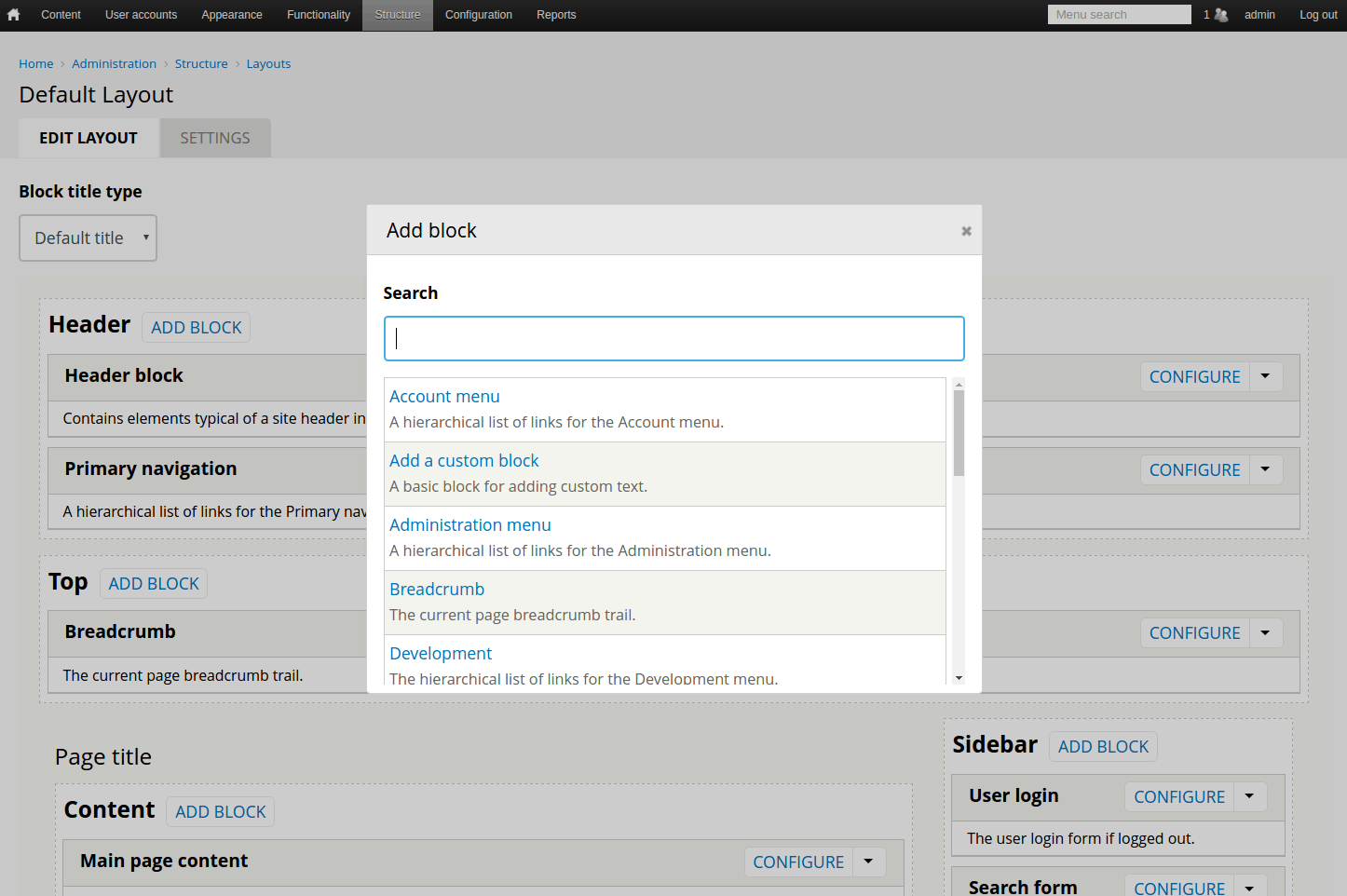Backdrop CMS
 | |
|
Screenshot  Backdrop CMS Layout Admin. | |
| Initial release | January 15, 2015[1] |
|---|---|
| Stable release |
1.5.1 [1]
/ 17 October 2016 |
| Development status | Active |
| Written in | PHP |
| Operating system | Unix-like, Windows |
| Platform | Cross-platform |
| Size | 36 MB (uncompressed Backdrop CMS core) |
| Available in | Multilingual |
| Type | Content management framework, Content management system, Community and Blog software |
| License | GPLv2 or later[2] |
| Website |
backdropcms |
Backdrop CMS is a free and open-source content management system written in PHP and distributed under the GNU General Public License.[2] Backdrop CMS is a fork of the Drupal project.[3] Drupal is used as a back-end framework for a large number of Web sites ranging from personal blogs to corporate and government sites.[4]
The Backdrop CMS project forked from Drupal about 2 years into the Drupal 8 development cycle. At that time the code was very similar to that of Drupal 7—it was before the adoption of Symfony, before the conversion to PSR-0 autoloaders, before the removal of almost all Drupal code that was not object-oriented, and before widespread rewrites of many subsystems. Backdrop's founders and early contributors saw the huge changes coming to Drupal, and figured many in the community wouldn't be able (or willing) to make the jump.
Backdrop CMS's philosophy is focused on providing an affordable yet comprehensive CMS for small to medium sized businesses, non-profits, educational institutions, and other organizations.[5] Because Backdrop CMS is very similar to Drupal 7 a module that was written for Drupal 7 can be ported to Backdrop CMS far more quickly than to Drupal 8.[3] There is also a built-in upgrade path from Drupal 7 to Backdrop CMS.[6] It should be more affordable to upgrade an existing Drupal 7 site to Backdrop than to migrate it to Drupal 8.[3]
The core Backdrop CMS package aims to include many useful features, but only those that are necessary for the majority of sites using it. Backdrop can be easily extended with the addition of modules[7] (that change the way it works), themes[8] (that change the way it looks), and layouts[9] (that change the way content can be placed on the page).
Built-in features that are improvements over Drupal 7
There are a number of improvements that were made both before and after Backdrop CMS was forked, including:
- configuration management tools (for developers to transfer/deploy configuration between servers)
- a visual query builder (for site builders to generate advanced listings of specific content) - the views module
- a rich text editor (for content creators to create pages and posts) - the wysiwyg_ckeditor module
- automatic URL generation based on patterns - the pathauto module
- responsive layouts, core theme, and admin bar
- improved performance
- improved usability
Further reading
- Migrating from Drupal to Backdrop by Todd Tomlinson[10]
- Beginning Backdrop CMS by Todd Tomlinson[11]
See also
- Comparison of web frameworks
- List of applications with iCalendar support
- List of content management systems
References
- 1 2 "Roadmap". backdropcms.org. Retrieved 2016-04-15.
- 1 2 "Licensing FAQ". backdropcms.org. Retrieved 2016-04-15.
- 1 2 3 "Backdrop CMS: Setting the record straight". Drupal Watchdog. 2014-06-01. Retrieved 2016-04-15.
- ↑ "The State of Drupal 2010 speech". Archive.org. 2001-03-10. Retrieved 2011-08-31.
- ↑ "Philosophy". Backdrop CMS. Retrieved 15 April 2016.
- ↑ "Upgrade from Drupal". Backdropcms.org.
- ↑ "Modules". backdrop cms.
- ↑ "Themes". backdrop cms.
- ↑ "Layouts". backdrop cms.
- ↑ Tomlinson, Todd (2015). Migrating from Drupal to Backdrop. Apress. ISBN 978-1-484217-59-7.
- ↑ Tomlinson, Todd (2016). Beginning Backdrop CMS. Apress. ISBN 978-1-4842-1969-0.